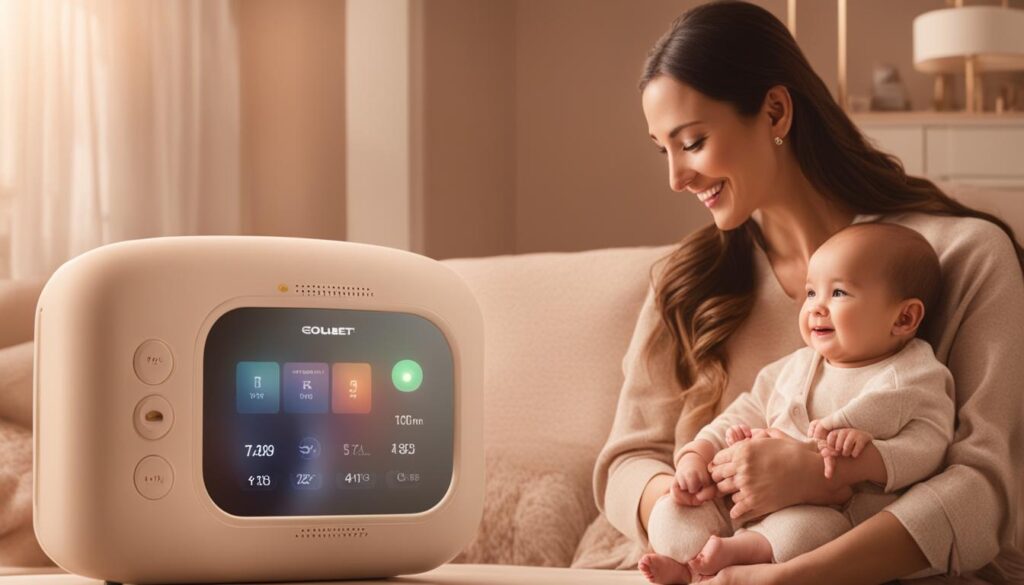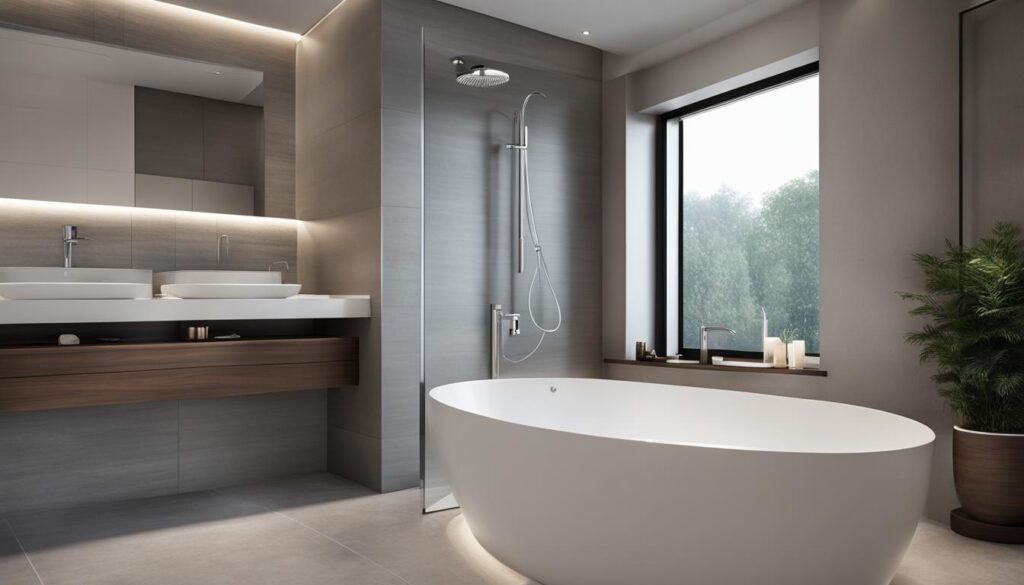We may earn money or products from the companies mentioned in this post.
Being a new parent comes with a lot of responsibility, and ensuring the safety of your little one is at the top of the list. With so many baby safety products on the market, it can be overwhelming to know where to start. In this guide, we will provide you with essential knowledge on baby safety products that every parent needs to keep their infants secure.
From baby safety gates to locks, monitors, and harnesses, we will give you all the information you need to make informed decisions for your family’s safety. With our comprehensive guide, you can worry less and enjoy the joys of parenthood.
Key Takeaways
- Baby safety products are essential to creating a safe and secure environment for your little one.
- Investing in top-rated baby safety essentials can give you peace of mind and ensure your baby’s safety.
- By implementing baby safety tips and measures, you can prevent potential hazards and accidents from occurring.
- Baby safety gates, locks, monitors, and harnesses are just a few of the many baby safety products available on the market.
- Be sure to choose the right baby safety products for your particular needs and the needs of your child.
Baby Proofing and Child Proofing Tips
When it comes to baby safety, baby proofing and child proofing your home is essential. As your little one grows and becomes more mobile, they will start to explore their surroundings. It’s important to identify and eliminate any potential hazards to ensure their safety.
Identifying Potential Hazards
The first step in baby proofing and child proofing is to identify potential hazards in your home. Some common hazards include:
- Electrical outlets
- Sharp edges and corners on furniture
- Cords and blinds with loops
- Stairs
- Chemicals and cleaning supplies
- Small objects that can be swallowed
Take a walk around your home and try to see things from your baby’s point of view. Get down on the ground and crawl around to get a better idea of what they might be attracted to or what might be within their reach. Once you have identified potential hazards, it’s time to start baby proofing and child proofing your home.
Baby Proofing and Child Proofing Your Home
Here are some tips for baby proofing and child proofing your home:
| Area | Hazards | Baby proofing/Child proofing solution |
|---|---|---|
| Nursery | Cords, small objects, unstable furniture | Use cord organizers, keep small objects out of reach, anchor furniture to the wall |
| Kitchen | Chemicals, sharp objects, hot surfaces | Lock cabinets and drawers, use stove knob covers, put up a safety gate |
| Bathroom | Medications, cleaning supplies, slippery surfaces | Use cabinet locks, keep hazardous items out of reach, use a non-slip bath mat |
| Common areas | Electrical outlets, sharp edges, cords | Use outlet covers, edge and corner guards, cord organizers |
These are just a few examples of steps you can take to baby proof and child proof your home. It’s important to remember that no home is completely hazard-free, so it’s essential to always keep a close eye on your little one.
Other Baby Safety Tips
Here are a few additional baby safety tips:
- Never leave your baby unattended, especially on elevated surfaces like changing tables or sofas
- Always use a proper car seat and make sure it’s installed correctly
- Keep your baby’s sleep area clear of any loose blankets or toys
- Make sure your smoke detectors are working properly
- Learn CPR
By following these baby proofing and child proofing tips, you can create a safe and secure environment for your little one to explore and grow in.
Baby Safety Checklist for the Home
As a responsible parent, ensuring the safety of your little one is a top priority. This comprehensive baby safety checklist will guide you through the essential safety measures you need to take to baby-proof your home effectively. By following these steps, you can create a safe and secure environment for your baby to explore and grow:
- Check your windows and doors: Make sure all windows and doors have secure locks that your baby cannot open. This prevents your baby from falling out of windows or wandering outside without supervision.
- Install smoke alarms and carbon monoxide detectors: Place smoke alarms and carbon monoxide detectors in every room of the house. Test them regularly to ensure they are working optimally.
- Secure furniture: Anchor all furniture to the wall, especially bookshelves, dressers, and cabinets. This will prevent tipping or falling that can harm your baby.
- Cover electrical outlets: Cover all electrical outlets with safety caps to prevent your baby from inserting their fingers or other objects that could lead to electric shock.
- Keep chemicals locked away: Store all cleaning supplies, detergents, and other toxic chemicals in a locked cabinet or high up out of reach of your baby.
- Use safety gates: Place safety gates at the top and bottom of stairs and in front of rooms with hazardous materials.
- Create a safe sleep environment: Place your baby to sleep on their back in a crib with a firm, snug-fitting mattress and no soft bedding or toys.
- Keep small objects out of reach: Keep small objects and toys with small parts away from your baby to prevent choking hazards.
- Be cautious with hot items: Be careful when handling hot liquids and food to prevent burns. Keep hot items away from the edge of tables and counters where your baby could reach.
- Ensure water safety: Always supervise your baby during bath time and never leave them unattended around water, even in a shallow pool or bathtub.
By following this baby safety checklist, you can ensure that your home is safe and secure for your little one. Don’t forget to update your safety measures as your baby grows and becomes more curious and mobile.
Baby Safety Gates: Creating Barriers for Safety
When it comes to ensuring the safety of your little one, creating barriers to potential hazards is essential. Baby safety gates are an excellent tool for achieving this goal, providing a physical boundary to prevent access to unsafe areas.
There are two main types of baby safety gates: pressure-mounted and hardware-mounted. Pressure-mounted gates are held in place by tension, while hardware-mounted gates are screwed into the wall or doorway. Hardware-mounted gates are generally considered to be the safest option, as they are less likely to become dislodged or loosened over time.
| Pros of Pressure-Mounted Gates | Cons of Pressure-Mounted Gates |
|---|---|
| Easier to install | Can be dislodged or moved by a determined child |
| No damage to walls or doorways | Not as sturdy as hardware-mounted gates |
| Portable and easy to move to different locations | Not recommended for use at the top of stairs |
When selecting a baby safety gate, make sure to choose one that fits securely in the intended location and has no gaps that could allow a child to slip through. The gate should also be tall enough to prevent climbing and durable enough to withstand the wear and tear of daily use.
Tips for Installing Baby Safety Gates
- Measure the width of the doorway or stairway before purchasing a gate
- Install the gate according to the manufacturer’s instructions
- Make sure the gate swings away from the staircase
- Ensure the gate is properly latched before leaving your child unattended
With proper installation and use, baby safety gates can be an effective way to keep your little one safe and secure. Consider investing in a sturdy and reliable gate that meets your specific needs, and enjoy the peace of mind that comes with knowing your child is protected.
Baby Safety Locks: Securing Cabinets and Drawers
As your baby starts to crawl and explore their surroundings, it’s crucial to secure all cabinets and drawers in your home that may contain hazardous materials. Baby safety locks are a great way to ensure your little one stays safe and out of harm’s way.
There are several types of baby safety locks available, including magnetic locks, adhesive locks, and sliding locks. Magnetic locks are installed inside the cabinet or drawer and only open when the magnetic key is placed on the outside. Adhesive locks are attached to the outside of the cabinet or drawer and lock with a latch. Sliding locks are installed on the inside of the cabinet or drawer and lock by sliding a piece of plastic across the front.
When choosing the right baby safety lock for your home, consider the type of material the lock will be attached to and how easy it will be for you to operate while also keeping your little one out. Most baby safety locks come with simple installation instructions and often require no tools or drilling.
Installation Tips for Baby Safety Locks
When installing baby safety locks, make sure you follow the instructions carefully and position the lock in a location that is out of reach of your baby. Here are some general installation tips:
- Clean the surface where the lock will be attached to ensure optimal adhesion
- Allow the adhesive to cure for the recommended amount of time before use
- Test the lock several times to ensure proper installation and functionality
Benefits of Baby Safety Locks
Baby safety locks provide several benefits to parents and caregivers, including:
- Peace of mind knowing your little one can’t access hazardous materials
- Added security for your home and belongings
- Easy installation with no drilling or tools required
- Different options to fit your needs and preferences
“Baby safety locks are an essential item for any home with a mobile baby. They provide a simple yet effective way to keep your little one safe and secure while giving you peace of mind.”
Investing in baby safety locks is a simple and affordable way to ensure your baby’s safety at home. By taking the necessary precautions and implementing safety measures like baby safety locks, you can create a secure environment for your little one to explore and grow safely.
Baby Safety Monitor: Keeping an Eye on Your Little One
A baby safety monitor is a game-changer for parents who want to keep an eye on their baby’s activities, even when they’re not in the same room. With so many different types of baby monitors on the market, it can be tough to choose the right one for your needs. In this section, we’ll highlight some of the key features and benefits to look for when selecting a baby safety monitor.
Types of Baby Monitors
There are two primary types of baby monitors: audio and video. Audio monitors allow you to hear your baby’s sounds and cries, while video monitors provide a live feed of your baby’s activities. Some monitors also come with additional features, such as temperature sensors, night vision, and two-way communication.
When choosing a baby monitor, it’s essential to consider your lifestyle and habits. If you’re always on the go, a portable monitor that can easily be moved around might be the best choice. On the other hand, if you spend most of your time at home, a video monitor that can be mounted to the wall might be a better option.
Features to Look for in a Baby Monitor
When selecting a baby safety monitor, there are several key features you should consider to ensure the safety of your little one. These include:
- Range: Make sure the monitor has a good range, so you can keep an eye on your baby from different parts of the house or garden.
- Sound and video quality: Look for a monitor with clear sound and video quality to ensure you can hear and see your baby clearly.
- Alerts: Choose a monitor with customizable alerts that will notify you when your baby is crying, has woken up, or when the temperature in the room has changed.
- Security: Ensure that the monitor you choose has a secure connection, so you can be sure that no one else can access the video feed.
- Battery life: Select a monitor with long battery life to avoid frequent charging and ensure you won’t lose connection unexpectedly.
Tips for Using a Baby Safety Monitor
Once you’ve chosen a baby safety monitor, there are a few tips you can follow to ensure you get the most out of it:
- Place the monitor away from your baby’s reach to prevent any accidents.
- Test the monitor before using it and ensure that you can hear and see everything clearly.
- Keep the monitor away from other electronics that could interfere with the signal.
- Make sure the monitor is always on and in range to ensure your baby’s safety.
Investing in a baby safety monitor can provide peace of mind for new parents and caregivers. With a range of options available, be sure to choose a monitor that you trust, is easy to use, and has the features you need to keep your little one safe and secure.
Baby Safety Harness: Ensuring Safety on the Go
As a parent, keeping your baby safe is your top priority. But when you’re on the go, it can be challenging to ensure that your little one stays secure. That’s where baby safety harnesses come in. These products are designed to keep your baby safe and secure while you’re out and about.
There are several types of baby safety harnesses available, including backpack harnesses, wrist harnesses, and chest harnesses. Each type has its own unique benefits and features, and it’s important to choose the right one for your needs.
| Type of Harness | Benefits |
|---|---|
| Backpack Harness | Allows your baby to carry their own things, freeing up your hands |
| Wrist Harness | Keeps your baby close and prevents them from running off |
| Chest Harness | Designed for use in strollers and high chairs, keeping your baby secure while sitting |
No matter which type of baby safety harness you choose, it’s important to use it properly. Make sure that the harness fits your baby comfortably and securely, and always follow the manufacturer’s instructions for use.
Remember, a baby safety harness is not a substitute for close supervision. Always keep an eye on your little one, even when using a safety harness.
When shopping for a baby safety harness, look for products that are well-made and durable. Check for any safety certifications or standards that the harness may have, such as compliance with the Consumer Product Safety Commission (CPSC).
Overall, a baby safety harness can be a valuable tool for keeping your little one safe on the go. By choosing the right type of harness and using it properly, you can provide your baby with an added layer of security and peace of mind.
Conclusion
As a parent, ensuring the safety of your little ones should be of utmost priority. By investing in a range of baby safety essentials such as safety gates, locks, monitors, and harnesses, you can create a safe and secure environment for your baby to thrive and grow in.
It is important to keep in mind that while these products can help prevent accidents, they do not replace proper supervision and vigilance. Always keep a watchful eye on your baby and try to anticipate any potential hazards that may arise.
Final Thoughts
We hope that this guide has provided valuable insights into the essential baby safety products and tips every parent needs to keep their infants secure. Remember to always prioritize your baby’s safety and take proactive steps to eliminate any potential risks.
Thank you for taking the time to read this guide. We wish you and your little ones a safe and happy journey together.
FAQ
What are some essential baby safety products every parent should have?
Some essential baby safety products include baby safety gates, baby safety locks for cabinets and drawers, baby safety monitors, and baby safety harnesses.
How can I baby proof my home?
To baby proof your home, you can secure furniture, cover electrical outlets, install safety gates, use cabinet and drawer locks, and use corner guards to protect your baby from sharp edges.
What should be included in a baby safety checklist for the home?
A baby safety checklist for the home should include securing furniture, covering electrical outlets, installing safety gates, using cabinet and drawer locks, and ensuring a safe sleep environment.
What types of baby safety gates are available?
There are pressure-mounted gates, hardware-mounted gates, and retractable gates. The choice depends on the location and specific needs of your home.
How do I install baby safety locks?
Baby safety locks can be installed using adhesive or screws, depending on the type of lock. Follow the manufacturer’s instructions for proper installation.
What features should I look for in a baby safety monitor?
Look for features such as video and audio monitoring, night vision, two-way communication, and temperature monitoring to ensure your baby’s safety and well-being.
How do I properly use a baby safety harness?
When using a baby safety harness, make sure it fits securely and comfortably on your baby. Always supervise your baby while using the harness and follow the manufacturer’s instructions for proper usage.
Affiliate Disclosure: This post may contain affiliate links. If you purchase through our link, we may receive a small commission, but at no additional cost to you. For more information, please see our Disclosure statement.



